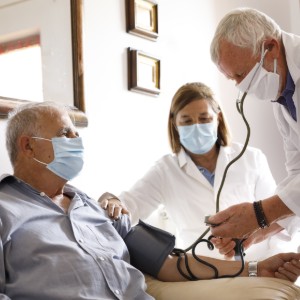By Dr. Jeremy Cauwels, Chief Medical Officer at Sanford Health Plan; Dr. Patrick Courneya, Chief Health Plan Medical Officer at HealthPartners; Dr. Julia Joseph-Di Caprio, Chief Medical Officer at UCare; Dr. John Mach, Chief Medical Officer at Medica; Dr. Marc Manley, Chief Medical Director at Hennepin Health; Dr. Abigail Miller, Chief Medical Officer at PreferredOne; and Dr. Mark Steffen, Chief Medical Officer at Blue Cross and Blue Shield of Minnesota
Let there be no doubt, extensive preparations have been made to protect patients visiting Minnesota’s hospitals and clinics amid the COVID-19 pandemic. But if we want to mitigate additional harm from this crisis, it’s imperative that Minnesotans seek medical care when they need it.
While we continue to do everything we can to minimize the spread of COVID-19 – including washing our hands, wearing masks in public and practicing social distancing – we must also get the preventive, routine and follow-up care that protects and improves our health. Statistics reveal that this is not happening at an alarming rate, and that could ultimately lead us to a more serious public health crisis.
As Star Tribune reporter Joe Carlson wrote in his June 16 article titled “COVID-19 fears keep millions of Americans from seeking hospital care,” people across the nation are jeopardizing their health and well-being by avoiding hospital care, even in medical emergencies, for fear of contracting COVID-19. Local hospital systems have reported significant drops – from 35-50% – in emergency room (ER) visits during the March-April timeframe of this year. Nationally, there’s been a 42% decline in ER use, according to a recent study from the Centers for Disease Control and Prevention.
Clinic visits are also down significantly across the state. That means Minnesotans are not getting the non-emergency and preventive care they need to help stop or curtail chronic illnesses like cancer, diabetes and hypertension – which are worsening already significant health disparities among underserved communities throughout Minnesota. According to an analysis by Epic Health Research Network, screening appointments for breast, colon and cervical cancer dropped 94%, 86% and 94% respectively in March 2020 across 23 states, compared to the average number of appointments before January 20, 2020.
The decline in clinic visits also means babies, children, teens, as well as adults, are not receiving the necessary vaccinations to prevent the spread of other infectious diseases like measles – and in just a few months, the seasonal flu. According to a report from Healthcare Purchasing News, MMR (measles, mumps, rubella) doses in Minnesota were down 71 percent toward the end of March. If layered on top of COVID-19, a surge in either of these infections could deal a devastating blow to our state.
It’s important to learn the facts about non-COVID-19 hospital and clinic visits, as well as the implications of avoiding necessary medical care. Following are some key things to know:
- If you experience symptoms consistent with heart attack, stroke, infection, appendicitis or other conditions that demand immediate care, you’re better off going to the hospital than staying at home.
- Minnesota’s hospitals and clinics have put extraordinary safety measures in place to protect patients, including enhanced personal protection equipment (PPE), universal patient screenings, surface cleaning, airflow improvements, hallway traffic management, and the separation of patients into potential-COVID and non-COVID groups.
- Vaccinations are critical. If routine vaccinations decline, there will likely be outbreaks of vaccine-preventable diseases amid the ongoing COVID-19 pandemic. Getting all necessary vaccinations for you and your loved ones is one of the best things you can do to protect both personal and public health.
- Telehealth is a great alternative to an office visit. You can often utilize this convenient form of care delivery if you’re hesitant to leave your home. Telehealth can be used for routine checkups and other medical interactions, and most health plans will cover these virtual visits as if they were done face to face.
Some recent data suggest that non-COVID patients are starting to seek medical care more often. An analysis from TransUnion Healthcare found outpatient hospital visits down 31% nationally in mid-May vs. 64% in early April. But the decline is still far too steep. We are urging Minnesotans to seek medical attention for serious illnesses and get all necessary vaccinations for themselves and their children. Seeking medical care is not only smart – it will be vital if we are going to prevent the spread of other serious illnesses.